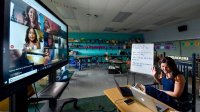Takeaways From Distance Learning
An instructional coach makes the case that “business as usual” will not be the right path once students return to traditional classrooms.
Your content has been saved!
Go to My Saved Content.The Covid-19 pandemic has wreaked havoc: tragic loss of life, economic disruption, and educational turmoil. In the wake of such chaos, many of us are searching for fragments that suggest something—anything!—good will come out of this chapter in world history.
Those anxious to boost learning through edtech met recent disappointment reading Dr. Arran Hamilton and Professor John Hattie’s recent report “Not All That Glitters Is Gold"; it suggests that the overall impact of digital technology on learning has not fundamentally changed since the 1970s. Quality of teaching, they suggest, remains the single most important component to successful education, no matter what the context and no matter what the tools.
A ‘Tech-tonic’ Shift
In pre-Covid times, the adoption of edtech was slowed, primarily, by two factors: limited time for professional development and the existence of good-enough conventional teaching methods. However, there’s good reason to believe that things will be different moving forward. For those of us who have been teaching virtually for almost a year now, pushing pedagogy through an electronic pipeline has bred creative adaptations.
I believe the pandemic will be viewed as an incubation period when teachers’ love for children spurred unprecedented technological innovations. My hope is that the material conditions for supporting larger-scale changes are here and will begin showing up in the next wave of educational research studies. In fact, new research supporting this view is already emerging.
Durable Enhancements
Some enhancements of pandemic-era instruction will persist. Here’s what I think those durable power-ups are, as well as how to apply them to your classroom.
More experience and familiarity with edtech: The first and most obvious improvement is that all teachers are now more adept users of technology in general. As new edtech continues to emerge, its adoption will be accelerated by improved instructor skill and confidence. Teachers will become better and better at experimenting with new tools and quickly zeroing in on the ones that truly work.
More consistent consideration of end-user experience: While student-centered learning has long been a primary goal among educators, teaching through a tech lens has made “end-user first” essential. This has meant simplifying communications, reducing visual clutter on lesson presentations, and seeking regular feedback from students. Ideally, teachers will survey their students frequently—and let them know what their feedback has influenced so that students have more ownership of their learning.
Increased cognitive empathy: Regardless of your opinion on the student-camera issue, increased sensitivity to student anxiety and trauma can only improve relationships. But the true benefit of allowing students this privacy is that many teachers without visual access to student faces have come to rely on other—arguably more accurate—ways of gauging student comprehension. Interactive technology like Nearpod, Pear Deck, and Flipgrid will continue to provide the most equitable form of classroom participation, the one where all students contribute. When teachers use interactive tools to check for understanding in class, they’re better prepared to identify and clear up misconceptions before kids leave the room.
A better understanding of how to use in-class time: Teachers will continue to use synchronous and asynchronous learning where they have the most impact. Students will get back the small-group collaboration and peer interactions they’ve been craving, while maintaining their access to on-demand content. Ideally, teachers will continue to create lean six-minute videos that distill what would have previously been 30-minute lectures, and they’ll continue to supplement these videos with info-gap activities; structured partner discussions; and time for meaningful, student-generated questions.
Game Changers
Other shifts will be more transformative; these big-picture changes will, I believe, dramatically alter student motivation and engagement.
More effective differentiation: Harnessing curiosity and joy in learning will be more achievable because teacher- and organization-curated curricular and pedagogical materials archives will improve. This will open the floodgates for blended and self-paced learning to occur more consistently. Effective differentiation can become the norm as teachers harness learners in producing the conditions of their own differentiation. Kareem Farah’s Modern Classroom Project is already turning this vision into reality.
Greater emphasis on mastery: The tension between offering unlimited reassessment (which we know is key for fostering a growth mindset) and the difficulty in grading on a deadline will fade. Constant, tech-augmented, individualized feedback will fuel and channel student energy, leading the shift from grading as compliance to mastery-based grading policies—and shed the busywork that doesn’t just bore students but demoralizes them by tanking their grades. Mastery-based grading would foreground the criteria for success of the content standards and inspire students by showing them how to reach their goals. (For more on this, check out work by Susan Brookhart, Thomas R. Guskey, Jay McTighe, and Dylan William; Rick Wormeli; and Matt Townsley.)
Learning Gains
Every time I read an article or opinion focused on learning loss, I cringe. While the sentiment comes from the heart—we all want what’s best for our children—we should recognize that such a concept is rooted in what Zaretta Hammond calls “deficit thinking.” Somewhat arbitrarily, people decided the standards for what students should know and be able to do at each grade level; likewise, people can reimagine what standards are (or should be) again. When all of the kids get back into buildings, we’re going to find that they have learned quite a lot during this pandemic—even if some of it is not on the official curricula. And that’s OK.
If you find what I’m saying here foolishly sanguine, consider how much you’ve learned this past year—personally and professionally. In my experience, coaching educators through these difficult times, I have yet to meet a teacher who resists incorporating what they’ve learned going forward—who wants to go back to business as usual. Recognizing this as a legacy moment for everyone involved in education may be the most fitting way to honor the cost of getting here.
